Removing and replacing old glazing putty from single pane window frame to remove the glass is one of the all time most hated jobs by tradesmen and DIY’ers alike.
Essentially, removing single pane glazing is as simple as prying away any old putty (or glazing compound) from the window frame and softening any stubborn areas with a heat gun or linseed oil as required.
Once the putty is gone, remove any glass retaining nails and then the glass should pop straight out.
This may sound like a very simply straight forward job, but if you have never done it before there is a fairly wide scope for things to go wrong, so read on below for tips on how to remove old putty with the minimum of fuss.
Why was Glazing Putty Used?
Back in the days before upvc and double glazing, windows were traditionally formed by using either steel (usually galvanized) or timber to build the frame and a single pane of glass was dropped into it.
Small nails or spriggs as they are also known were then hammered down into the frame to hold the glass in place.
Contrary to what some people think, it’s the nails that hold the glass in the frame and not the glazing putty. The glazing putty is simply there to seal the glass to the frame and prevent any draughts or water ingress into the frame.
This common misconception does lead some DIY’ers to try and replace panes of glass into frames just using the putty to hold it with not much success and more often than not a smashed pane of glass on the floor.
Fortunately, if the window putty was applied correctly in the first place, it can last for many many years before it needs to be replaced, so thankfully, this shouldn’t be a job that needs to be done too often.
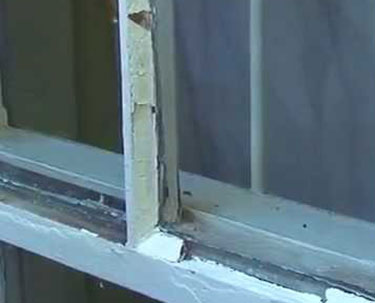
A single pane glazed window using traditional putty to seal it that’s now old and damaged
A Quick Note on Asbestos and Lead Paint
If your windows are particularly old and have never, or at least not in the last 30 years, had the putty replaced then there is a chance that the putty itself may contain asbestos.
If there is even the slimmest of chances that this may be the case then you should definitely not attempt to touch or disturb the putty in any way! It will need to be removed by specialists in a controlled manner.
For more information on the dangers of asbestos and also on a DIY testing kit that can be used to test any suspect putty for traces, see our project on asbestos here.
Besides the dangers posed by asbestos, you also need to be aware of the dangers posed by lead paint.
Again, if the windows you’re working on haven’t been touched or restored since the late 80’s or early 90’s, there’s a chance that the existing paint could contain lead.
To find out more about lead paint and how to strip it safely, see our project on stripping lead paint here.
How to Remove and Replace Glazing Putty and Single Pane Glazing
As we have established, this is a bit of a tricky, delicate and time consuming job that essentially involves prying or hammering next to a thin pane of glass – a recipe for disaster!
Aside from this, if you work carefully and take your time then it’s more than possible to remove the old glazing putty and piece of glass and replace the whole lot and still get a good finish.
As with any DIY job and this is no exception, always wear suitable protective gear and clothing. Decent hand any eye protection is an absolute must. One stray hammer blow can easily shatter the glass, sending shards all over the place, so make sure you’re protected!
Step 1 – Remove the Window if Possible
To make the job a little easier, if you can, remove the whole window and frame so that you can work on it on a flat level surface. This will make things a little easier.
If you’re working on a side or top opening section you should be easily un bolt it from the carriers and remove it.
With the window removed find a nice solid and level bench to place it on. A purpose built workbench is best but a Workmate or similar will also be perfectly fine.
Ensure that no areas of the glass itself are resting on anything. If they are, the second any pressure is applied the glass will break.
Once in place on a flat surface, clamp the window down so that it can’t move while you’re working on it. When clamping up, try to clamp using the centre of the window frame and again, ensure that none of the glass is under any pressure.
Tip: Place a thick sheet or blanket between your window and your work surface before clamping it down. This will help to absorb any vibrations caused when hammering that could potentially crack the glass.
If you unable to remove the window you will have to work on it where it is. This makes things a little more difficult, but certainly not impossible.
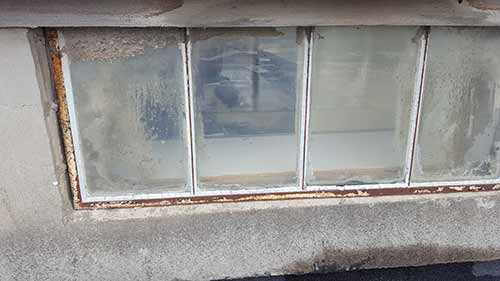
Old galvanized steel window needing urgent putty replacement – The window could not be removed so had to be repaired where it was
Step 2 – Chisel out Putty
With your window firmly clamped it’s time to start chopping out the old putty.
If you are removing the putty in order to replace the glass because it’s damaged or you have inadvertently smashed it, then we don’t need to worry about keeping it safe and we can also save a bit of time by smashing the remains now. This will make getting the putty off much easier.
Before putting a hammer straight through it, put on some decent eye protectors and thick cut resistant glove and then place an old thick sheet or towel over the glass covering it fully and gently tap it with a hammer to break it up.
Once all broken up, pull any remaining shards out (with your gloves on) and collect up as much of the glass as possible and dispose of it.
If you are definitely wanting to save your pane of glass, firstly using a razor blade or sharp knife, run it around the very edge of the putty where it meets the glass to break the seal.
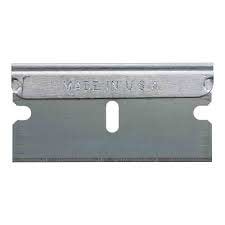
A razor blade or sharp knife can be used to break the seal and loosen the putty from the glass
Repeat this for several passes, applying a little pressure each time to edge further into the putty.
With this seal broken, it’s time to start chopping the putty out!
The best tool to use for chopping out old putty is a hacking knife (seen in the image below) as it’s made specifically for chopping out putty, filler, old cement and similar materials.
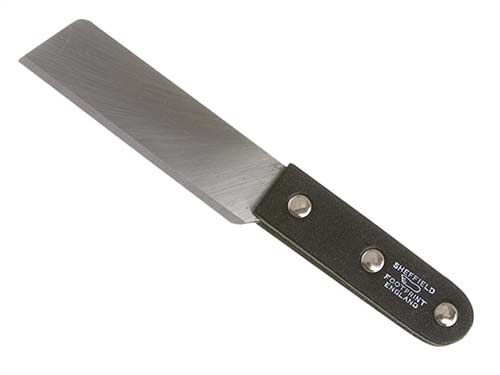
Hacking knife used for removing putty from single pane traditional window
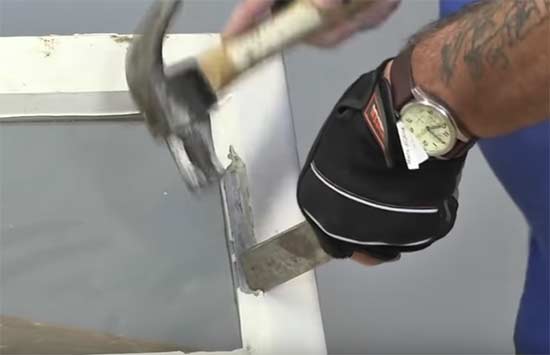
Using a hacking knife to remove putty from an old window frame
Starting in the middle of one side of the window, take your hacking knife and hold the blade edge against the putty at roughly 45° (as in the image below), with the blade roughly in the centre of the putty surround.
Using a hammer, gently tap on the flat edge of the knife until you see it cutting into the putty. The hacking knife is deliberately not razor sharp to prevent damage to the frame which always happens if you use a wood chisel.
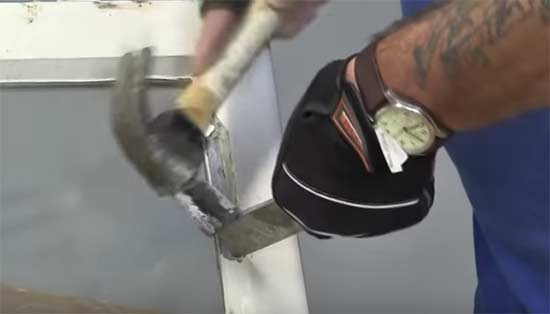
Tap the top of the hacking knife gently down to chop out the old putty from the window frame
Keep tapping the hacking knife down towards the frame and the chunks will ping off. You will soon get used to how hard you can hit it.
Which ever way your frame is lying, always hit down towards the frame. Never hit down towards the glass or you will smash it.
Once you have removed a chunk of putty you should be able to see how deep it is and where the frame is so that you know exactly how deep you can hit the knife down without accidentally chopping into the frame.
Continue chopping away the old putty along the surround, ensuring that you get right down into each corner.
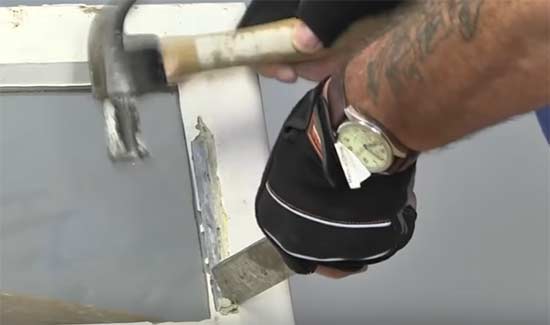
Make sure that you get the hacking knife right down into each corner to remove all the window putty
Move yourself around the window as you chop, don’t be tempted to contort yourself into some awkward position as this is how accidents happen and damage is caused.
Carefully work your way around the perimeter of the glass, chopping out any and all putty with the hacking knife as you go until all putty has been removed.
To soften any hard putty you can use a heat gun. Heating the putty up will cause it to go soft and make removing it much easier.
Run the heat gun over the putty from side to side, being careful not to concentrate any heat in one spot for too long as if glass gets too hot it will crack. You can use some thick pieces of timber cut to length to shield the glass from the direct heat from the gun.
Once soft you should then be able to chop it out.
Step 3 – Clean the Frame of any Remaining Putty
With all the major chunks of putty removed, the next job is to go around the frame and remove any small lumps or bumps that remain.
This is an essential step if you are hoping to remove any glass in one piece without damage as even the smallest of lumps is enough to prevent the glass from moving freely. If it can’t move freely and easily then there’s a good chance it’s going to get damaged.
Pay particular attention to any corners as this is where glass is at its weakest.
The best tools to use for fine cleaning any remaining putty from your window frame is still a hacking knife but to really get deep into those corners you may also find a putty knife or window scraper useful as they are a little sharper.
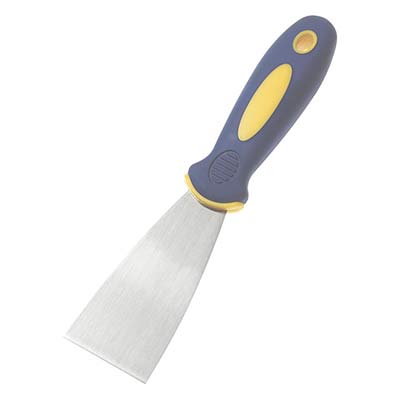
You can use a putty knife to remove any remaining putty from the window frame

You can also use a window scraper to fine clean any remaining putty from the window frame
Step 4 – Remove Nails or Window Pins and Glass
With all the putty now gone you should be able to clearly see any nails (spriggs) or window pins. These are the final obstacle to overcome in order to finally remove the glass.
Nails or window pins can be a little tricky to remove due to the fact they are so close to the glass.
The best method of removing nails or window pins is to either pry them up with a small screwdriver if you are able to get any purchase or use a pair of needle nose pliers to grip the head and pull them out.
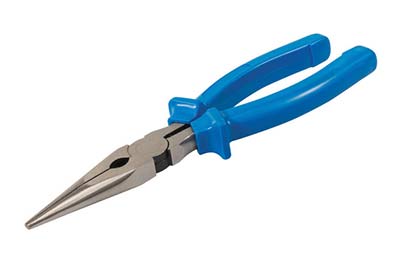
Needle nose pliers are one of the best tools to use to remove window nails or window pins
As they are not hammered in too far, due to the need to actually hold the glass, as long as you can get a good grip on them they should come out fairly easily.
Work your way around the window removing any and all nails or pins as you go.
Once they have all been removed, do a final check for anything that could restrict the glass from coming out and then give the glass a very gently push with the flat of your hand on one of the edges.
If it moves freely that’s great news! Carry on and remove the pane and put it to one side out of the way.
If not then its probably been bonded in using silicone or a similar sealant. In this situation, use a razor blade to run around the edge of the glass on both sides and then see if you can move it.
If it still doesn’t budge, try a silicone sealant remover/dissolver to see if this will affect it enough to enable you to push the glass out.
After trying all of these and it still won’t shift, you may find your only choice is to smash the glass and remove it that way.
Step 5 – Prime the Window Frame
Once the glass has been removed, use a window scraper and piece of sandpaper to thoroughly clean the inside of the window reveal or “rabbet groove” as it’s also known so that it is free from any form of sealant, putty or old paint.
Once thoroughly cleaned prime it with a decent exterior wood primer or paint system such as the Dulux Weathershield system or Sadolin or similar. A microporous paint system is also a great solution as this will allow the timber breath as well as allow the paint to flex along with expansion and contraction so that it doesn’t crack.
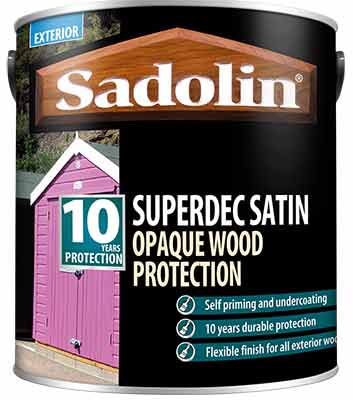
Microporous paint ideal for treating rabbet grooves on windows before refitting single glazed panes of glass
Step 6 – Clean the Glass and Refit to Window Frame
With the inside of your frame or rabbet groove now primed and undercoated as required it’s time to get the glass back in.
Run a very thin bead of silicone around the rabbet groove as this will help to seal the glass and prevent any draughts or water ingress. Although the new putty that you’re going to apply will take care of this job, it won’t hurt and will provide an additional layer of protection.
However, if you are planning on removing the glass again in the near future you may want to skip this as it will make the glass harder to get back out.
Carefully rest the glass back into the recess or rabbet groove and ensure an even gap all around the perimeter.
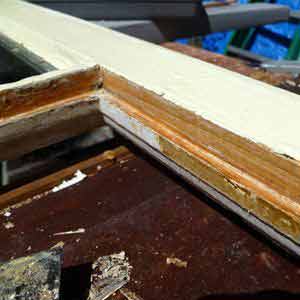
Once cleaned the glass can the be refitted back into the rabbet groove of the window
With the glass in place you can now fix nails/panel pins or window pins around to hold the glass in the frame.
This can be fairly difficult as knocking anything it with a hammer this close to a thin piece of glass is asking for trouble, but if you have a steady hand it is possible to use a small tacking hammer to knock in the nails or window pins.
If you’re not confident in doing this you can use a “brad pusher or panel pin setting tool” to push in any nails or brads and you can also use the edge of a putty knife or scraper to “push” window pins in.
As window pins and the very small nails (or brads or finishing nails) you will be using here are very thin they can easily be pushed into a timber window frame.
Just be careful when applying an pressure to any area around the glass. Make sure the pressure is not being applied to the glass itself or in any way that the tool you’re using can slip!
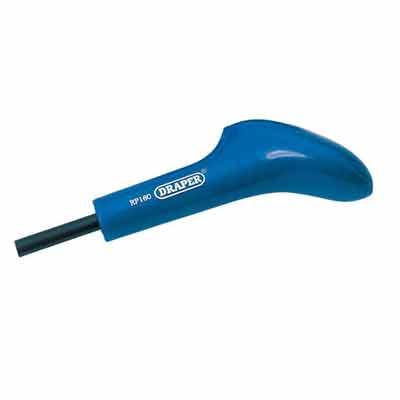
Brad pusher or panel pin setting tool
Step 7 – Apply new Putty
Once any nails or pins have been fixed in place to hold the glass in the frame, it’s now time to apply some putty.
In terms of the putty itself, there are quite a few types available, but generally the best glazing or window putty is a Linseed oil based putty as their easy to work with and last a decent amount of time.
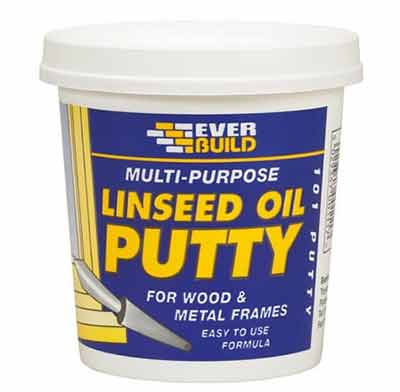
Linsee oil based glazing putty
Occasionally, in order to make Linseed-based putties workable you will need to warm it up. To do this, boil a kettle and pour the boiling water into a pan and then place the sealed tub of putty into the water. This will warm the putty inside and make it much more malleable and workable.
Once it’s nice and workable mix the putty thoroughly to make sure all the oil is mixed throughout the putty evenly as it tends to separate when left in the tub for a while.
To apply the putty around the window frame, roll a section of it out into a “sausage” so that it’s about 10-12mm in diameter and then place it along one edge or use a putty knife to scoop it from the pot and apply it to the groove.
Repeat this until you have covered the entire internal edge.
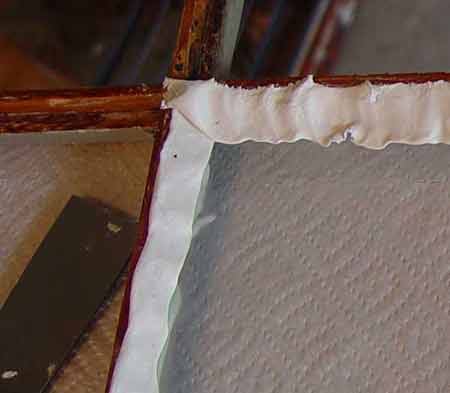
Glazing putty applied around rabbet joint of window ready to be pushed into the joint and smoothed – Image courtesy of oldhousefix.com
To get it nice and smooth, use a putty knife of filling knife. First put some white spirit on the edge of the knife to lubricate it, this will help you to get a good finish.
Hold the front edge of you knife flat down on the glass at 45° and pull it back into the putty, gently forcing the putty into the joint. Make sure you only apply gentle pressure into the joint and not on the glass.
Work your way around the window working the putty into the joint as you go. Don’t worry too much about getting it smooth at this stage, we’re just concentrating on ensuring the joint is completely full with no air gaps or dips and that the putty sits at a nice 45° angle as this is the correct angle for glazing putty.
Make sure you dip your putty knife regularly in white spirit to keep it lubricated.
Once you have completed one pass of the full window, start again from the beginning, this time smoothing over any lines and rough patches. Repeat this for as many times as you need until your putty is perfectly smooth.
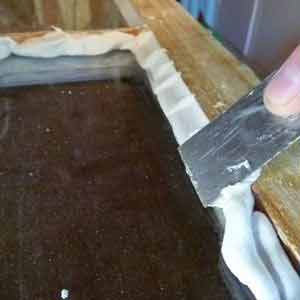
Glazing putty pushed into rabbet joint and smoothed out – Image courtesy of popularmechanics.com
In terms of getting your putty smooth in the corners and getting a nice crisp line, this can be a little tricky. Ideally, each corner should be mitered at a perfect 45° angle at each 90° corner. Use your putty knife to form each mitre and then smooth it out.
Once all of your lines and mitred corners are smooth, use your putty knife to tidy up the joint where the putty finishes on the glass. This should also be as perfect a straight line as you can get it.
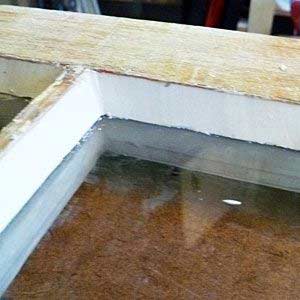
Glazing putty formed into a mitre joint in corner of window – Image courtesy of popularmechanics.com
If you need to remove any excess putty, use your putty knife to pull it away from the edge towards the centre of the pane of glass. You can then wipe it away.
With your putty now all smoothed and corners formed at nice crisp 45° mitred angles you’re pretty much done. The only thing left to do now is to wait for your putty to dry and then get some paint on it.
Depending on the type of putty you have used, this can be anything from a few hours to a few weeks. If you opted to use a Linseed oil based putty then you should be looking at about 2 weeks before it is dry enough to paint.
Check your manufacturers recommended drying times which should be stated on the tin or packaging your putty came in. One other way to check is after a week or so, very gently rest your finger on the putty. If it’s hard then it’s set and ready for painting.
Step 8 – Painting Glazing Putty
Once your putty is hard ans set you will then need to paint it. This is essential as putty will last much much longer once it’s painted, normally anything up to 10 years. If unpainted, putty will only last up to around 1 year.
When painting your putty, also make sure that you paint over the joint where the putty meets the glass to seal it and prevent any water or moisture getting in. You should overrun you paint onto the glass roughly 3-5mm to get a good seal.
You may be tempted to skip this step due to the fact that that it will make the job look untidy but please don’t, it is a necessary step! If you keep your painted line as straight and crisp as possible it will still look just as good.
Once painted and dried you’re now done. Your single pane glazed window should now be good for at least 8 years or so.
Chopping out and removing old putty from a single pane glazed window certainly isn’t the nicest of jobs to do, but if you take your time and work carefully and methodically it’s certainly one that you can get a neat, tidy professional looking finish with.
Can you put new Putty Over old Putty?
In answer to this, yes you certainly can apply new putty over existing old putty, but you will need to make sure that any old putty that you leave is in good condition.
If you have a window where some of the putty has started to crack and fall out it is possible to remove any loose bits and just replace these as opposed to removing the whole lot.
However, when we say good condition we mean there are no splits or cracks in it and also that it is stuck nice and firmly to the rabbet groove and also the glass.
It is also possible to repair cracked putty. Mix boiled linseed oil with some glazing putty to create a thin paste then force the paste into any cracks in existing putty using a small brush.
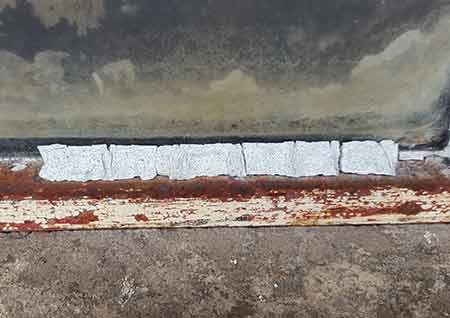
Old and cracked glazing putty that needs repairing or replacing
Once dried, this will plug any splits and gaps, but as with replacing putty, to ensure it lasts it will need to be painted.
Aside form this, to ensure the best possible protection and finish for your putty it is always best to do the job properly, remove all the putty and replace it with new.
Are There Alternatives to using Glazing Putty?
In answer to this question, yes there are alternatives to using glazing putty, the obvious one being just to replace the window with a new double glazed unit.
In some situations and locations it isn’t always possible to do this. If you have single pane sash windows and live in a conservation area then it may be stipulated by your local authority that you have to have this type of window.
If this is the case or you like the look of a traditional single pane glazed window then the other alternative to using glazing putty is to use a timber bead, timber moulding or timber quadrant (different names for the same thing).
Timber beads, mouldings or quadrants come is a range of different shapes, styles and designs but the most common is the half round (seen in the image below).
As you can see the moulding is shaped very much like the putty when it’s applied to the window and gives the same crisp and clean finish.
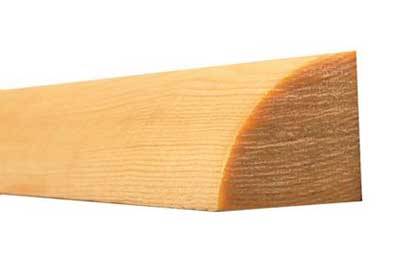
Timber beads or quadrant can be used in place of glazing putty
As with the putty, all corners are mitre cut to not only look neat but to also provide a good seal.
Before any mouldings are fixed in place on a window a thin bead of silicone is run around the rabbet groove to create a seal and then the bead is fixed in place using small nails or brads.
As with the putty, to get the best and most long lasting finish, the bead or quadrant will need painting.

